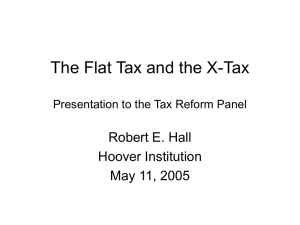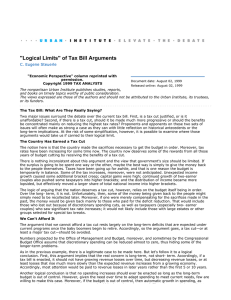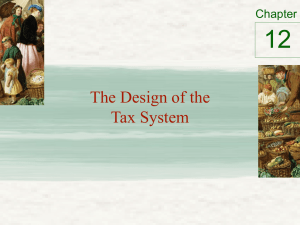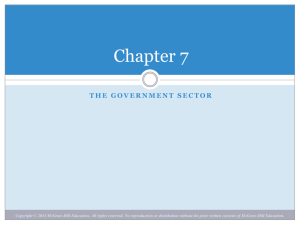Mitchell Slides 2012
advertisement
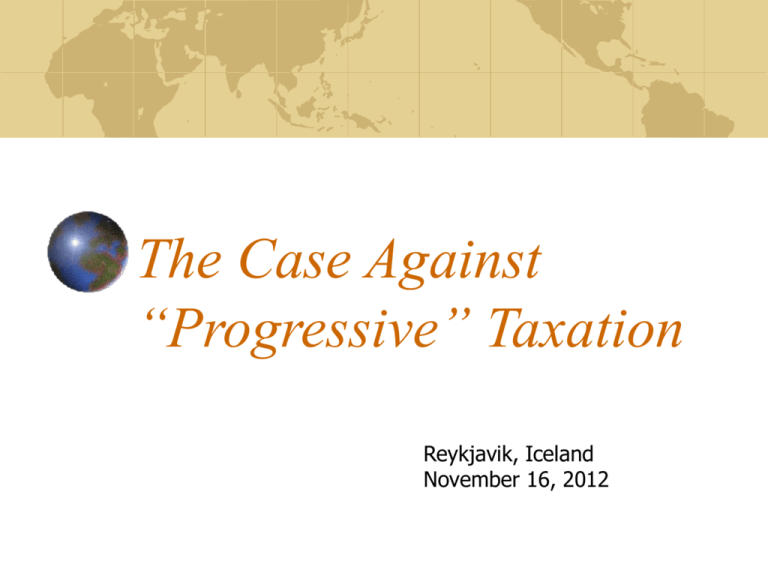
The Case Against “Progressive” Taxation Reykjavik, Iceland November 16, 2012 What Is Economic Growth? More labor More capital Better efficiency of labor Better allocation of capital Labor and capital are the ingredients The chef mixes the ingredients Years Needed to Double Economic Output 7 percent growth 6 percent growth 5 percent growth 1 4 percent growth 3 percent growth 2 percent growth 1 percent growth 0 10 20 30 40 50 60 70 80 Two Fundamental Fiscal Issues What’s the appropriate – or growthmaximizing – size of the public sector? Classical liberal vision? Welfare state? What’s the best (or least worst) way of extracting revenue? Low rate and broad based? Punitive and redistributive? Not All Gov’t Spending Is Equal Core public goods such as rule of law and protection of property rights associated with growth. Physical and human capital spending can be helpful to prosperity…or it can be wasteful and inefficient. Transfer and consumption spending are unambiguously linked to weaker economic performance. Size of Government Matters…a Lot There is a “Rahn Curve” relationship between government spending and economic growth similar to the “Laffer Curve” relationship between tax rates and tax revenue. Burden of Government Used to be Small 50 Expenditures as a percent of GDP 45 Sweden 40 UK 35 US 30 Japan 25 Germany France 20 15 10 5 0 1870 1913 1920 1937 Source: Tanzi and Schuknecht, "Reforming Government: An Overview of Recent Experience," 1960 Burden of Gov’t Today Is Large Average burden of spending in advanced nations is more than 40 percent of GDP. Most of that spending is for transfer and consumption outlays. This leads to misallocation of labor and capital, reducing prosperity. It also means ever-higher tax burdens that penalize productive behavior. What is Good Tax Policy? Tax economic activity at a low rate. Define the tax base correctly, taxing economic activity only one time. Tax all economic activity alike, since neutrality ensures economic criteria rather than tax provisions determine resource allocation. Tax only economic activity inside national borders, the common-sense notion of territorial taxation. Why Have a Low Tax Rate? The marginal tax rate – the burden on the next increment of income – must be kept low. A low marginal tax rate rewards productive behavior. People will work more, save more, and invest more. Incentives to hide, shelter, under-report income are lower when the marginal tax rate is reasonable. Research indicates that the marginal tax rate should be no higher than 20 percent. Why Tax Income Only One Time? Many nations impose multiple layers of tax on income that is saved and invested. This is the wrong definition of the tax base. Taxes on interest, dividends, capital gains, and inheritances are examples of the discriminatory treatment of capital. This is a self-destructive policy since it harms the activity – capital formation – that all economic theories agree is necessary for economic growth and rising living standards. Why Neutrality? Government should not pick winners and losers. Special preferences and penalties distort the allocation of capital and undermine efficiency, leading to lower incomes. Special preferences and penalties also encourage taxpayers to squander time and energy in search of political advantage instead of concentrating on productive behavior. So Why Have One Tax Rate? As a matter of economic theory, it doesn’t matter. Iceland’s former flat tax system was not as good as the “progressive” system in Singapore. The single rate in Iceland was almost twice as high as the top progressive rate in Singapore. The goal is to have low marginal tax rates. The Moral Argument for One Rate The rule of law should apply equally to everyone. If you apply for a license to run a business, the rules shouldn’t vary based on your income. If you commit a crime, the rules shouldn’t vary based on your income. If you file a property deed, the rules shouldn’t vary based on your income. The Taxpayer Unity Argument A so-called progressive system allows politicians to play divide and conquer. They can target one group of taxpayers in a certain year. Then they can target another group the next year. Because only a small group of taxpayers each year are affected, politicians can more easily raise taxes. The Massachusetts example. The Administrative Argument Having one low rate, broadly applied, minimizes the compliance burden for both taxpayers and the state. But the broad and neutral tax base is very important. A single rate, however, is important if you want to tax capital income at the source. That also enables considerable simplicity. Protecting the Poor Argument This is not about the existence of a “zerobracket” amount. Instead, it is the notion that keeping tax rates low on the “rich” is the best way to keep tax rates low on the poor. In western nations, tax increases follow a pattern – class warfare provisions followed by tax increases on the less fortunate. Look at history in the U.S. and U.K. The Laffer Curve Higher tax rates discourage people from earning and reporting income. To determine the impact of a tax policy change on tax revenue, which effect dominates: The rate change or the change in taxable income? Answer can vary over time since even small changes in long-run growth rates can have a large effect over time because of compounding. Tax Rates, the Rich, and Revenue In 1980, there were 116,800 rich people. Those rich people reported $36.2 billion of income to the IRS. They paid $19.0 billion of income tax to the federal government. Tax Rates, the Rich, and Revenue In 1980, there were 116,800 rich people. Those rich people reported $36.2 billion of income to the IRS. They paid $19.0 billion of income tax to the federal government. By 1988, there were 723,700 rich people. Those rich people reported $353.0 billion of income to the IRS. They paid $99.7 billion of income tax to the federal government. Conclusion Website: www.cato.org Policy videos: www.youtube.com/afq2007 Twitter: @danieljmitchell Blog: www.danieljmitchell.wordpress.com


